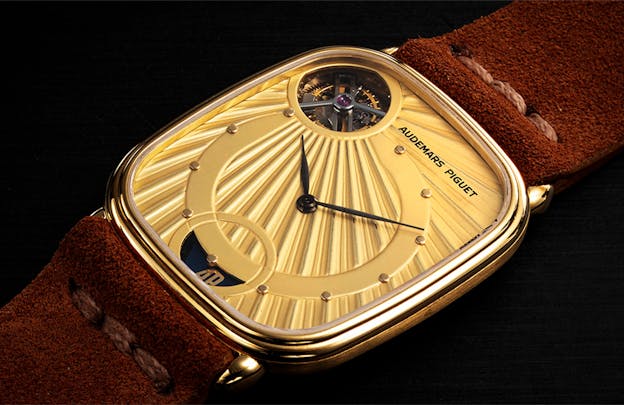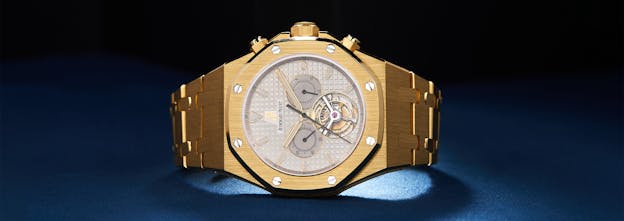End The Year With A Bang With A Massive Royal Oak Tourbillon Chronographe In Gold
Big, bold and gold – but there’s real watchmaking beauty in this beast.
The predominant sentiment nowadays when it comes to watch size is that smaller is better, at least relatively speaking. The days when watches seemed to get bigger every year are long gone, and for most of us, the sweet spot is generally around 40mm or under, especially for simpler watches. Certainly, Enzo Ferrari’s 30mm Rolex chronograph, reference 3055, is convincing proof that you don’t need a big watch to be a big presence in the world, in every sense of the word.
There was a time, however, when Giants Walked The Earth, back in the late 1990s and early 2000s, during which time, to be a statement watch meant, by and large, being large. With so many of today’s most revered watches coming in on the smaller side it is tempting to see in such physically big pieces, a certain kind of boastful gaucherie, however there is no doubt that sometimes what you want is not the horological equivalent of nouvelle cuisine, but rather, a medium rare 45 ounce tomahawk, and don’t skimp on the hash browns.

In the spirit of the old saying that nothing succeeds like excess, A Watch A Week is proud to close out this tumultuous year with a watch that in its ursine heft, represents all the unabashed joy to be found in really going big.
The Royal Oak Tourbillon Chronographe has enough gold in it to put a smile on the face of Goldfinger – at 44mm, and with a solid gold matching bracelet, it is diametrically opposed to the diffident, stealth-luxury aesthetic prevalent in so much modern watchmaking and watch design. You have to wonder how such a watch would land if it were released today – there’s no doubt that it’s a visual and tactile statement piece and that its size is an intrinsic and essential part of its personality.

Tim Mosso reviewed this watch for us and he was at pains to point out – and I ought to get this out of the way at the outset – that the size of the case itself is just the beginning of the story; if you include the rigid interlinks that attach the bracelet to the case, you have a rigid lug to lug distance of 61.5mm and in his view, if you don’t have at least an 18 centimeter/7 inch wrist, you are not going to find the Royal Oak Tourbillon Chronographe a good fit (Enzo Ferrari, who was six foot two, could probably have pulled it off just fine). It’s not a particularly thick watch all things considered, at about 13mm, but I can only emphasize along with Tim that this watch is big, I tells ya – we’re talking nearly a pound of yellow gold here, albeit it is a pound of gold absolutely dressed to the nines in terms of finishing.
Now, there is a tendency to hear a case size like 44mm and at that point, decide that a watch is not for you, and Lord knows that I have led with case size myself but it turns out that there is quite a lot more to this watch than just its physical dimensions. The Royal Oak Tourbillon Chronographe debuted in 2002, at which time the Royal Oak Offshore had already accustomed AP collectors and enthusiasts to larger watches. The Offshore, nicknamed “The Beast,” was first released in 1993, with the first gold model coming out in 1996, although amazingly enough, the first gold Offshore ref. 25721BA was at 42mm, actually smaller than the Royal Oak Tourbillon Chronographe – this is one of the largest non-Offshore Royal Oak models AP ever produced. Despite its size, however, the Royal Oak Tourbillon Chronographe gives up nothing to any other Royal Oak (or Offshore) in terms of quality, with all the care and craftsmanship in the construction and finishing of the case and bracelet that you could possibly hope for.

The movement is an extraordinary piece of work, even by the high standards of complicated watchmaking from Audemars Piguet. The hand-wound caliber 2889 was, when the Royal Oak Tourbillon Chronographe was released, the first tourbillon chronograph that Audemars Piguet had ever produced and the movement has been used in relatively few watches since it debuted – about a dozen or so versions of the Royal Oak Tourbillon Chronographe, of which there were two references in yellow gold and on matching yellow gold bracelets. The first version, is the one we have this week and, as far as I have been able to determine, the movement was created by Renaud & Papi, the complications specialist which AP acquired in 1992.
Other than a handful of Royal Oak watches (the majority of which were stainless steel) the movement has shown up in three Jules Audemars watches, and that’s about it, although there were a couple of openworked variations as well. It’s a piece of very classic watchmaking in many respects, with a lateral clutch and three day power reserve. This is an integrated tourbillon chronograph, not a modular construction, with a Breguet overcoil balance spring, running at 21,600 vph in 25 jewels, and the movement, in good old fashioned Swiss Vallée de Joux style, is engraved, “Adjusted to heat, cold, and five positions.”

The tourbillon is rightly associated with Breguet, but at least in wristwatches, it ought to be just as strongly associated with Audemars Piguet. The company produced the first series produced automatic tourbillon in 1986, the caliber 2870, and that watch was not only the first selfwinding tourbillon but also the world’s thinnest tourbillon of any kind for several decades.

The Audemars Piguet caliber 2870 had a crown on the back for setting the time, but it could not be hand wound (you had to shake the watch back and forth in order to wind it, via a hammer winding system). The 2870 was succeeded by the caliber 2875, which was larger and more robust but which had the same hammer winding system and caseback setting crown of the 2870, and it, in turn, was replaced by a tourbillon with three arms on the cage, which was used by a number of different brands (including Cartier and Richard Mille) and which, at Audemars Piguet, usually had a y-shaped upper tourbillon bridge, as seen in the Royal Oak Tourbillon Chronographe. This is, more or less, the third generation of tourbillons from Audemars Piguet however you don’t see this version of the tourbillon in AP’s current Royal Oak collection at all, which is devoted exclusively to flying tourbillons – as a matter of fact, of all the tourbillons AP currently produces, the only tourbillon with an upper bridge (non-flying) left in AP’s current lineup, is in the Code 11.59 Collection.
So we began with what seemed like a dated, somewhat ungainly behemoth but what we actually have is a large, but very historically important watch, with considerable technical interest to back up its physical dimensions.
Interestingly enough, tourbillon watches with chronographs are relatively rare, probably for several reasons. The first is that traditionally a chronograph gear train is driven off the movement fourth wheel and you can’t do that with a tourbillon, at least as they are traditionally constructed. A tourbillon cage is normally driven at its pinion by the movement third wheel, and rotates around a fixed fourth wheel once per minute; the pinion of the escape wheel rotates against the fixed fourth wheel teeth, transmitting energy to the lever and then to the balance in the usual way. This means that if you want to have a chronograph as well as a tourbillon, you need additional gearing for the chronograph driving wheel (which normally is on the fourth wheel axis). If you take a close look at this AP, you’ll see that there is a small seconds sub-dial at 9:00, which might seem redundant since the tourbillon rotates once per minute and could easily be pressed into service as a seconds hand (and in fact lots of tourbillon watches do just that).
If you now examine the movement through the display back, you’ll see that the driving wheel for the chronograph is right behind the seconds hand, which turns once per minute – this allows for a more or less standard layout for the chronograph lateral clutch system and minutes counter.

A tourbillon chronograph is technically not extraordinarily challenging to design but it does have to be constructed quite precisely – of course this is true of most watches, but if you’re combining a tourbillon with a chronograph, you’re putting together two complications which draw a lot of torque from the mainspring. You always have to be careful in designing and setting up a chronograph that the balance amplitude doesn’t drop too much when you switch the chronograph on (a problem the vertical clutch largely addresses, although depending on your tastes you might feel that this is at the expense of the intuitively pleasing aesthetics of a lateral clutch) and the problem is compounded when you add that extra energy demand to that required to drive the tourbillon cage and its contents.

Such a movement tends to be expensive to produce and somewhat limited in its versatility as between the tourbillon, and the chronograph works, there is not a tremendous amount of room for adding any other complications (and there is probably not much extra energy left over either). For this reason they are rare complications. Audemars Piguet is almost alone among high end watch brands in having several different tourbillon chronographs in its current collection, albeit you have to make up your mind between a few very un-traditional designs, as the combination is only found in the Code 11.59 and Royal Oak Offshore collections. Vacheron makes one – just one – in the Traditionnelle Collection, and I have been unable to find a tourbillon chronograph in either Patek or Lange’s current lineup. Jaeger-LeCoultre, another company that certainly could make a tourbillon chronograph if it were so inclined, doesn’t have one either, and, for a wonder, neither does Breguet.
This is still, without a doubt, a massive watch but there is something appealing about its unapologetic excess in size and design, especially with the somewhat unusual combination of complications. It is to be sure, something of an anachronism in design (and in engineering, a least in some respects) but then again, so is the Mercedes Benz “Count Trossi” SSK. Like the car, the watch in question is an exercise in visual, tactile, and mechanical exuberance – and, understood in context, a surprisingly convincing exercise in excellent, if highly specific, taste as well.

